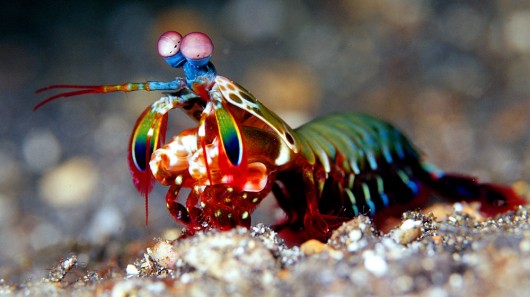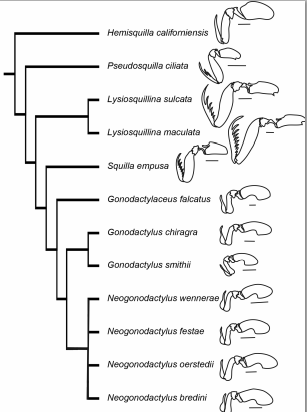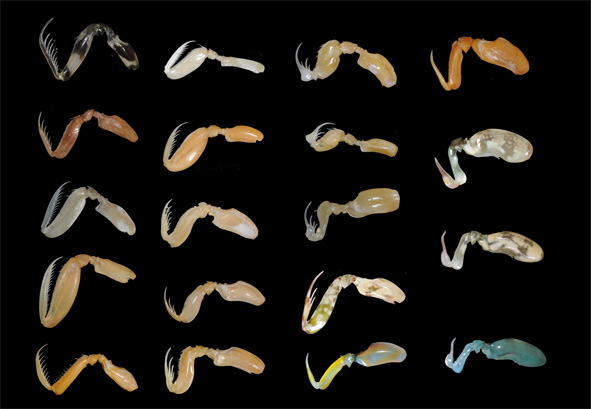Mantis Shrimp
Leah Cepko & Mason Kennon
Reed College: Biology Department (Animal Behavior - Fall 2014)

Phylogeny
Phylogeny is the study of ancestral relationships among groups of organisms over evolutionary time. The depiction of these relationships is a branched tree (as seen below in Figure 2) constructed using molecular sequencing data and/or morphological traits.
Phylogeny of Mantis Shrimp Species
Phylogenies developed using sequence analysis have revealed several interesting insights into the ecological and evolutionary history of the ~500 known mantis shrimp species and their impressive raptorial appendage. The current phylogeny of mantis shrimp species demonstrates that striker and smasher appendages have evolved only once (Anderson et. al 2014). The striker species were the first to diverge from the undifferentiated, ancestral condition. Smasher species appear to have diverged most recently from striker species and constitute a monophyletic group (Anderson et. al 2014). Several interesting observations can be made about the character evolution of the raptorial appendage and its function by reference to the current phylogeny. Divergence in hunting strategy of different mantis shrimp species groups is reflected by the significant morphological adaptation of the raptorial appendage. This divergence of mantis shrimp species and their raptorial appendage provides researchers several interesting insights into the evolution of biomechanical systems (Patek et al 2012).

Image is Figure 2 within Blanco et al 2014 (Evolution article)
Striker Species
Striker species have specialized to capture soft-bodied prey from large distances without the use of substantial force (Blanco et al 2014). The striker appendage resembles a spear, which is significantly thinner and longer relative to the ancestral condition. The spring mechanics of the appendage have evolved to maximize striking distance and minimize loading time, at the cost of significant reduction in maximum force output (Anderson et al 2014). Such adaptation allows striker species to quickly recognize evasive prey, load their appendage and strike at a prey item from significant distances from their body at impressive speeds. Clearly, the morphology and mechanics of the striker appendage have diverged from the undifferentiated ancestral condition because of selective pressures specific to the prey capturing system utilized by species group. Thus anatomical dimensions of the appendage have been modified to maximize the appendage’s function in the striker’s hunting strategy (Blanco et al 2014).
Smasher Species
Evolution of the smasher appendage is related to similar ecological pressures but demonstrates significant divergence. Smasher species rely primarily on hard-shelled sedentary species for prey. Consequently, they have evolved large, powerful appendages, which can smash shells at close distances (Blanco et al 2014). The smasher appendage is significantly thicker and has considerable mineralization that serves to significantly increase its resilience to mechanical stress (Weaver et al 2012). The spring mechanics of the appendage have evolved to maximize force output and release speed. Such adaption is at the cost of significant reduction in the reach of the appendage and an increase in necessary loading time. However considering the foraging strategy of these species, these factors have not been evolutionarily significant because smasher’s have specialized to sedentary, hard-shelled prey. Thus because of the sedentary nature of their prey, neither striking distance nor loading time have been constraining factors on the evolution of the smasher appendage.

Image courtesy of the Smithsonian-Department of Invertebrate Zoology
Evolution of the Raptorial Appendage
Both groups of species demonstrate divergence from the ancestral condition. It is clear that the divergent evolution of the smasher and striker raptorial appendage is related to the maximization of certain aspects of the appendage’s spring mechanics, which allow for optimal performance of the appendage in the species group’s hunting strategy. Niche specialization specifically related to the diet of mantis shrimp species has resulted in observable divergence in morphological attributes of the appendage and its use in the prey capturing system of mantis shrimp species.